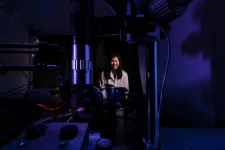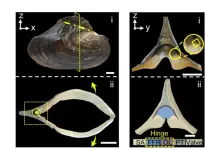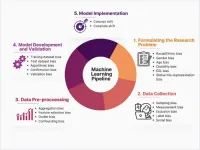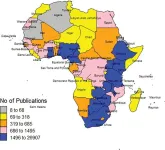(Press-News.org) The human nose, which has around 6 million olfactory receptors, can distinguish between at least 1 trillion different odors. Dogs have about 300 million of these receptors, with some scientists estimating their sense of smell is up to 100,000 times more powerful than humans’. This allows dogs to detect the scent of dangerous materials like bombs and illicit substances, as well as medical conditions such as COVID-19 and Parkinson’s disease.
University of Arizona assistant professor Judith Su is developing an optical nose “as sensitive as a bloodhound’s and as selective as an insect’s” to detect volatile organic compounds (VOCs), compounds with high vapor pressure at room temperature which emit odors. The optical nose could be used to detect anything a canine nose could, without the risk of putting real dogs in potentially dangerous situations.
“It would be really impactful to make an artificial dog to sense things in a noninvasive way, just through breath and vapors from our skin” said Su, a professor of biomedical engineering, optical sciences and the BIO5 Institute.
The work is funded by a $500,000 National Science Foundation CAREER Award, the organization’s most prestigious award in support of early-career faculty.
A Super-Powered FLOWER
Electronic noses, or e-noses, have been around for several decades, but even the most advanced are quite limited, with the ability to detect just a few dozen odors by detecting how scents interact with a synthetic polymer coating. They’re also unstable and slow. Su and her collaborators are creating a much more capable alternative by combining hypersensitive olfactory receptors with a powerful optical sensing platform developed in Su’s Little Sensor Lab.
Olfactory receptors are chemical receptors in cell membranes. When triggered by odorous compounds, they send nerve impulses to the brain, resulting in the experience of smell.
“Your olfactory receptors have been refined over thousands of years of evolution for the purpose of detecting these odorants,” Su said. “People haven’t really been able to use them in combination with sensors before because it’s a challenge to produce them and keep them in working form. When they’re present in your body, that’s the environment that they’re happy in. Once they are outside the body, how do you maintain that in a functional form?”
Su is working with collaborators at the California Institute of Technology and the University of South Florida who can manufacture mutated olfactory receptors with increased sensitivity to specific smells. These will be combined with Su’s Frequency Locked Optical Whispering Evanescent Resonator, or FLOWER.
FLOWER is an optical sensing platform that can detect ultra-small levels of molecules – in the past, it’s detected molecules like disease particles and toxic industrial chemicals. The technology works by sending waves of light around a tiny ring (about the size of a grain of table salt) about 6,000 times per nanosecond.
If FLOWER is set up to detect a toxic chemical in a water sample and the chemical is present, the chemical will alter the wave of light very slightly each time it makes the loop. Because the loop is done so many times so quickly, this slight effect is magnified enough to become detectable. FLOWER can be adapted to sense different kinds of molecules. In this case, it will work in tandem with specialized olfactory receptors to detect VOCs.
“This is simply changing what we’re putting on that surface for the selectivity,” Su said. “In this case, a human receptor used for smell.”
Sniffing Out Solutions
Detecting scents is new territory for FLOWER. One challenge is that VOCs usually exist in a gaseous state, rather than liquid. Along the way, the team may experiment with ways to imitate how humans and canines experience scent, such as coating the sensors in a mucous-like membrane or using an airflow that imitates the action of sniffing. Ultimately, Su envisions using hundreds of scent receptors, mirroring the way mammalian noses work.
“Ideally, we will someday have an array of sensors, each with a different olfactory receptor,” Su said. “It would be able to distinguish trillions of odors, just like a human would. Or, eventually, we can go larger, and get something as sensitive as a bloodhound.”
Su and her team will first test their setup using common aromatic compounds such as benzene, which is one of the compounds responsible for the scent of gasoline, and toluene, the smell of paint thinner. From there, they plan to introduce more complex scents. Eventually, they envision using machine learning to teach the system how to recognize increasingly nuanced combinations.
Su’s work also includes an educational component. She and her team will create a refractometer kit for K-12 students all over the world to perform food and water quality field studies. Additionally, they will create interactive learning resources high school teachers can use in their classes.
END
The nose knows: Career Awardee developing bioinspired optical sniffer sensor
With a prestigious grant from the National Science Foundation, a biomedical engineering and optical sciences researcher is creating a device that can sniff out diseases, dangerous chemicals and other substances with the sensitivity of a bloodhound
2023-06-22
ELSE PRESS RELEASES FROM THIS DATE:
The impact of populism on multinational corporations’ investment
2023-06-22
A stable economic and political environment is necessary for firms to feel secure while making long-term investment decisions, such as those related to investing in foreign countries (also known as foreign direct investment or FDI). Any threat to change legislative procedures in the foreign country can make it difficult for firms to predict the outcomes of such decisions. Populist leaders, who claim to represent the will of the people, often come to power by threatening to alter the established rules and procedures, generating ...
Is the U.S. ready for an African swine fever outbreak?
2023-06-22
In a new study, researchers from North Carolina State University used a computer model to understand how African swine fever (ASF) might spread among swine farms in the southeastern U.S. – and examined the effectiveness of existing response plans. They found that although control actions would help, an outbreak could still prove persistent and costly.
ASF is a highly contagious viral disease in pigs, with a mortality rate that can reach 100%. Additionally, infected pigs may not show symptoms before they die, potentially allowing the ...
NFL and NFL Players Association fund Emory University-led study of innovative pain management solutions
2023-06-22
The National Football League and the NFL Players Association (NFLPA) announced today they are awarding a grant to Emory University researchers to study innovative, first-of-their-kind, alternative pain management methods that could benefit NFL players and society at large. The researchers will investigate mindfulness-based intervention in sports medicine injuries.
The $200,000 grant was awarded by the NFL-NFLPA Joint Pain Management Committee (PMC), which aims to facilitate research to better understand and improve potential alternative pain management treatments for NFL players.
Emory’s winning ...
Research links increase in depression, COVID diagnosis in student-athletes
2023-06-22
Background
COVID-19 survivors may experience persistent neuropsychological disruptions such as lower satisfaction with life (SWLS), depression, and anxiety. While student-athletes are at low risk for severe COVID complications, the effect of COVID on mental health remains to be elucidated.
Objective
Compare patient-reported mental health outcomes for incoming collegiate athletes who did (COVID+) and did not (COVID-) have COVID-19.
Methods
79 COVID+ (79/178, 44.4%, 18.90±0.16 years) and 99 COVID- (99/178, 55.6%,18.95±0.16 ...
Heat spots reveal growth rate of a galaxy 12 billion years ago
2023-06-22
An international team of astronomers has drawn a temperature map of the dust drifting within one of the oldest spiral galaxies of the Universe which provides new insights into how fast the galaxy is growing. Until now researchers have only been able to measure the temperature of most distant galaxies in broad terms, without showing how temperatures vary in individual areas.
This research, described in a paper published today in Monthly Notices of the Royal Astronomical Society (MNRAS) shows unambiguous temperature variation within the distant galaxy indicating two distinct heat sources – a supermassive black hole at the centre of the galaxy, and the heat generated ...
Scientists learn from hinge in bivalve about fatigue resistance of materials
2023-06-22
Recently, flexible and foldable devices have developed at a dramatic rate. More and more foldable devices appear in people's lives. Long-term service requires the folded parts to endure repeated deformation which might cause fatigue damage to the devices. Consequently, the damage will affect the normal function of the devices. Inspired by the hinge of bivalve Cristaria plicata, which experiences hundreds of thousands of repeating opening-and-closing valve motions throughout the bivalve’s lifetime, a research team led by Prof. YU Shuhong collaborating with Prof. WU Hengan from the University of Science and Technology of China ...
Bias in AI algorithms could be mitigated by implementing new checklist
2023-06-22
In your coverage, please use this URL to provide access to the freely available article in PLOS Digital Health: https://journals.plos.org/digitalhealth/article?id=10.1371/journal.pdig.0000278
Article Title: Bias in artificial intelligence algorithms and recommendations for mitigation
Author Countries: Jordan, United States, Canada
Funding: The authors received no specific funding for this work. END ...
Africa's share of global HIV research output has increased from 5.1% to 31.3% over the last 35 years, but is still low compared to its relative burden of infections
2023-06-22
Article URL: https://journals.plos.org/globalpublichealth/article?id=10.1371/journal.pgph.0000544
Article Title: HIV research output in African Countries between 1986–2020
Author Countries: Nigeria, USA, UK
Funding: The authors received no specific funding for this work. END ...
How might generative AI models distort human beliefs?
2023-06-22
Generative AI models such as ChatGPT, DALL-E, and Midjourney all have features that may distort human beliefs through their transmission of false information and stereotyped biases, according to Celeste Kidd and Abeba Birhane. In this Perspective, they discuss how research on human psychology can explain why generative AI could be particularly powerful in distorting beliefs. The capabilities of generative AI have been exaggerated at this point, they suggest, leading to a belief that these models exceed human capabilities. People are predisposed to adopt the information of knowledgeable, confident agents like generative AI ...
Large herbivores slow Arctic tundra diversity losses associated with sea ice decline
2023-06-22
Tundra diversity, including plants, lichens and fungi, declined over a 15-year experiment in the Arctic due to warming temperatures mediated by the disappearance of sea ice, according to Eric Post and colleagues. However, the presence of large herbivores such as caribou and musk oxen slowed this decline, by affecting the plant understory with their different browsing behaviors, the researchers concluded. Their findings offer support for the idea that encouraging herbivore diversity in the tundra could temper some of the impacts of climate warming. Post et al. observed the interacting effects of warming temperatures, sea ice changes, tundra diversity and herbivore exclusion in ...
LAST 30 PRESS RELEASES:
Ants: An untapped resource in the development of antibiotics?
Archaeologists use AI to create prehistoric video game
Mitochondria migrate toward the cell membrane in response to high glucose levels
Tiny viral switch offers hope against drug-resistant bacteria
Most parents aware of early peanut introduction guidelines, but confused about details
HPV vaccine can protect against severe lesions of the vulva and vagina
Virtual care provision and emergency department use among children and youth
Quadrivalent HPV vaccine and high-grade vulvovaginal lesions
Insights into dry eyes gained from stem cell-derived tear glands
Researchers identify 166 human pluripotent stem cell lines available for use in clinical applications
Europa Clipper instrument uniquely observed interstellar comet 3I/ATLAS
UN University Report challenges climate change as sole trigger of Syrian Civil War, exposing governance failures in drought response
Real estate investment trust (REIT) acquisition associated with hospital closure and bankruptcy
New Raman imaging system detects subtle tumor signals
Boston Children’s receives a $7.5 million grant from Aligning Research to Impact Autism (ARIA) to provide clinical research coordination for the IMPACT Network
Spray-on antibacterial coating offers new protection for plants against disease and drought
ESMT Berlin study: What makes a first offer successful in negotiations
Groundbreaking ceremony marks the beginning of CTAO-South Array construction in Chile
Why swearing makes you stronger
What prevents more cancer patients from enrolling in potentially life-saving clinical trials?
UK’s worst-case climate risks laid bare for lawmakers
A decline in churchgoing linked to more deaths of despair
TAMEST announces Maralice Conacci-Sorrell, Ph.D., UT Southwestern Medical Center, as 2026 Mary Beth Maddox Award & Lectureship Recipient
Global study to evaluate whether dengue outbreaks can be anticipated earlier
Chonnam National University researchers propose innovative voltage-loop control for power factor correction
Accelerating next-generation drug discovery with click-based construction of PROTACs
Detecting the hidden magnetism of altermagnets
$7M gift supports health research, engineering and athletics at UT San Antonio
NU-9 halts Alzheimer’s disease in animal model before symptoms begin
Hospitals acquired by real estate investment trusts associated with greater risk of bankruptcy, closure
[Press-News.org] The nose knows: Career Awardee developing bioinspired optical sniffer sensorWith a prestigious grant from the National Science Foundation, a biomedical engineering and optical sciences researcher is creating a device that can sniff out diseases, dangerous chemicals and other substances with the sensitivity of a bloodhound



